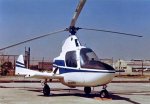Aviator168
Member
Will unloading the rotor reduce drag? The Eurocopter gets its speed by unloading its rotor (slow it down a bit), and the two little wings take care of 20 to 80 percent of the lift. I am wondering if the same scheme can be used on gyroplanes.

